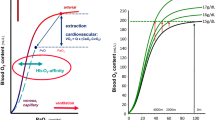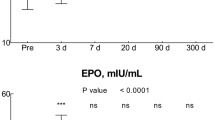Abstract
Erythropoiesis was studied in 11 subjects submitted to a 4-h hypoxia (HH) in a hypobaric chamber (4,500 m, barometric pressure 58.9 kPa) both before and after a 3-week sojourn in the Andes. On return to sea level, increased red blood cells (+3.27%), packed cell volume (+4.76%), haemoglobin (+6.55%) (P<0.05), and increased arterial partial pressure of oxygen (+8.56%), arterial oxygen saturation (+7.40%) and arterial oxygen blood content (CaO2) (+12.93%) at the end of HH (P<0.05) attested high altitude acclimatization. Reticulocytes increased during HH after the sojourn only (+36.8% vs +17.9%, P<0.01) indicating a probable higher reticulocyte release and/or production despite decreased serum erythropoietin (EPO) concentrations (−46%, P<0.01). Hormones (thyroid, catecholamines and cortisol), iron status (serum iron, ferritin, transferrin and haptoglobin) and renal function (creatinine, renal, osmolar and free-water clearances) did not significantly vary (except for lower thyroid stimulating hormone at sea level, P<0.01). Levels of 2,3-diphosphoglycerate (2,3-DPG) increased throughout HH on return (+14.7%, P<0.05) and an inverse linear relationship was found between 2,3-DPG and EPO at the end of HH after the sojourn only (r=−0.66, P<0.03). Inverse linear relationships were also found between CaO2 and EPO at the end of HH before (r=−0.63, P<0.05) and after the sojourn (r=−0.60, P=0.05) with identical slopes but different ordinates at the origin, suggesting that the sensitivity but not the gain of the EPO response to hypoxia was modified by altitude acclimatization. Higher 2,3-DPG levels could partly explain this decreased sensitivity of the EPO response to hypoxia. In conclusion, we show that altitude acclimatization modifies the control of erythropoiesis not only at sea level, but also during a subsequent hypoxia.




Similar content being viewed by others
References
Böning D, Maassen N, Jochum F, Steinacker J, Halder A, Thomas A, Schmidt W, Noe G, Kubanek B (1997) After-effects of a high altitude expedition on blood. Int J Sports Med 18:179–185
Eckardt KU, Boutellier U, Kurtz A, Schopen M, Koller EA, Bauer C (1989) Rate of erythropoietin formation in humans in response to acute hypobaric hypoxia. J Appl Physiol 66:1785–1788
Eckardt KU, Dittmer J, Neumann R, Bauer C, Kurtz A (1990) Decline of erythropoietin formation at continuous hypoxia is not due to feedback inhibition. Am J Physiol 258 :F1432–F1437
Erslev AJ (1991) Erythropoietin titers in health and disease. Semin Hematol 28 [Suppl 3]:2–7
Erslev AJ, Caro J (1987) Erythropoietin titers in response to anemia or hypoxia. Blood Cells 13:207–216
Fried W, Barone Varelas J (1984) Regulation of the plasma erythropoietin level in hypoxic rats. Exp Hematol 12:706–711
Ge RL, Witkowski S, Zhang Y, Alfrey C, Sivieri M, Karlsen T, Resaland GK, Harber M, Stray Gundersen J, Levine BD (2002) Determinants of erythropoietin release in response to short-term hypobaric hypoxia. J Appl Physiol 92:2361–2367
Gunga HC, Kirsch K, Röcker L, Schobersberger W (1994) Time course of erythropoietin, triiodothyronine, thyroxine, and thyroid-stimulating hormone at 2,315 m. J Appl Physiol 76:1068–1072
Gunga HC, Wittels P, Gunther T, Kanduth B, Vormann J, Röcker L, Kirsch K (1996) Erythropoietin in 29 men during and after prolonged physical stress combined with food and fluid deprivation. Eur J Appl Physiol 73:11–16
Hochachka PW, Gunga HC, Kirsch K (1998) Our ancestral physiological phenotype: an adaptation for hypoxia tolerance and for endurance performance? Proc Natl Acad Sci USA 95:1915–1920
Jelkmann W (1992) Erythropoietin: structure, control of production, and function. Physiol Rev 72 (2):449–489
Jelkmann W, Hellwig Burgel T (2001) Biology of erythropoietin. Adv Exp Med Biol 502:169–187
Kayser B (1992) Nutrition and high altitude exposure. Int J Sports Med 13 [Suppl 1]:S129–132
Lenfant C, Sullivan K (1971) Adaptation to high altitude. N Engl J Med 284:1298–1309
Lenfant C, Torrance JD, Reynafarje C (1971) Shift of the O2-Hb dissociation curve at altitude: mechanism and effect. J Appl Physiol 30:625–631
Lohman TG, Boileau RA, Massey BH (1975) Prediction of lean body mass in young boys from skinfold thickness and body weight. Hum Biol 45:245–262
Mairbäurl H, Schobersberger W, Oelz O, Bartsch P, Eckardt KU, Bauer C (1990) Unchanged in vivo P50 at high altitude despite decreased erythrocyte age and elevated 2,3-diphosphoglycerate. J Appl Physiol 68:1186–1194
Mide SM, Huygens P, Bozzini CE, Fernandez Pol JA (2001) Effects of human recombinant erythropoietin on differentiation and distribution of erythroid progenitor cells on murine medullary and splenic erythropoiesis during hypoxia and post-hypoxia. In Vivo 15:125–132
Milledge JS, Cotes PM (1985) Serum erythropoietin in humans at high altitude and its relation to plasma renin. J Appl Physiol 59:360–364
Richalet JP, Souberbielle JC, Antezana AM, Dechaux M, Le Trong JL, Bienvenu A, Daniel F, Blanchot C, Zittoun J (1994) Control of erythropoiesis in humans during prolonged exposure to the altitude of 6,542 m. Am J Physiol 266 :R756–R764
Savourey G, Garcia N, Besnard Y, Guinet A, Hanniquet AM, Bittel J (1996) Pre-adaptation, adaptation and de-adaptation to high altitude in humans: cardio-ventilatory and haematological changes. Eur J Appl Physiol 73:529–535
Savourey G, Garcia N, Caravel J-P, Gharib C, Pouzeratte N, Martin S, Bittel J (1998) Pre-adaptation, adaptation and de-adaptation to high altitude in humans: hormonal and biochemical changes at sea level. Eur J Appl Physiol 77:37–43
Sawka MN, Young AJ, Rock PB, Lyons TP, Boushel R, Freund BJ, Muza SR, Cymerman A, Dennis RC, Pandolf KB, Valeri CR (1996) Altitude acclimatization and blood volume: effects of exogenous erythrocyte volume expansion. J Appl Physiol 81:636–642
Sawka MN, Convertino VA, Eichner ER, Schnieder SM, Young AJ (2000) Blood volume: importance and adaptations to exercise training, environmental stresses, and trauma/sickness. Med Sci Sports Exerc 32:332–348
Semenza GL (2000) HIF-1: mediator of physiological and pathophysiological responses to hypoxia. J Appl Physiol 88 (4):1474–1480
Ward MP, Milledge JS, West JB (1995) High altitude medicine and physiology, 2nd edn. Chapman and Hall, London, p 497
Zhu H, Jackson T, Bunn HF (2002) Detecting and responding to hypoxia. Nephrol Dial Transplant 17 [Suppl 1]:3–7
Acknowledgements
The subjects of the Mountain Club of the ESSA LYON-BRON are acknowledged, as well as the technical assistance of A. Alonso, A.M. Hanniquet, J. Denis, A. Vouillarmet, R.M. Cottet-Emard and F. Grimbert. A special recognition is given to Médecin général Jacques Bittel.
Author information
Authors and Affiliations
Corresponding author
Rights and permissions
About this article
Cite this article
Savourey, G., Launay, JC., Besnard, Y. et al. Control of erythropoiesis after high altitude acclimatization. Eur J Appl Physiol 93, 47–56 (2004). https://doi.org/10.1007/s00421-004-1159-5
Accepted:
Published:
Issue Date:
DOI: https://doi.org/10.1007/s00421-004-1159-5




